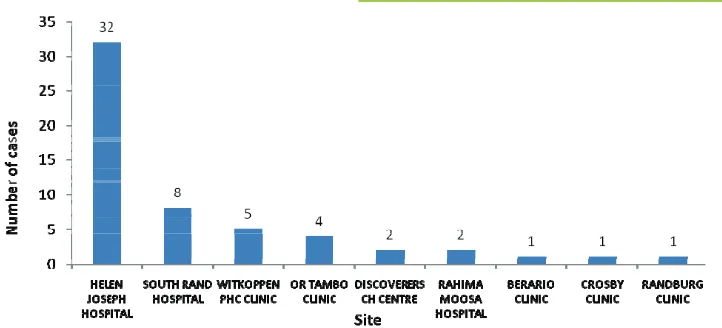1
CRYPTOCOCCAL SCREENING: AN UPDATE
Cryptococcal meningitis is a common AIDS-defining opportunistic infection and is the leading cause of laboratory-confirmed meningitis among adults in South Africa [1, 2]. In routine care settings, cryptococcal meningitis is associated with a case-fatality ratio of >50% at 12 weeks post-diagnosis [3]. There are several interventions with the potential to reduce the burden and mortality associated with cryptococcal disease, including earlier diagnosis of HIV infection and initiation of antiretroviral treatment (ART). Targeted screening of patients with a CD4+ T-lymphocyte count <100 cells/µl for cryptococcal antigenaemia is a newer intervention that has been suggested for routine implementation as part of the National Strategic Plan on HIV, STIs and TB, 2012-2016 [4]. Screening has the potential to detect patients with early cryptococcal disease (prior to development of meningitis) and thus prevent deaths.
With input and support from implementation partners including the Department of Health, cryptococcal screening was implemented at the NHLS CD4 laboratory at Charlotte Maxeke Johannesburg Academic Hospital on 3 September 2012. Twenty-five health care facilities, (including three regional hospitals) that refer specimens to this laboratory have begun participating in the programme. Blood samples submitted for a CD4+ T-lymphocyte count from these facilities have been tested for cryptococcal antigen (CrAg) using a
cryptococcal lateral flow assay (LFA) if the CD4+ T-lymphocyte count is less than 100 cells/µl. The LFA is a simple, quick test with high sensitivity and specificity and has been integrated into the CD4 laboratory workflow with only minor adjustments. Results for patients who test CrAg-positive are communicated by the laboratory to a pre-selected point of contact at the facility. A comment for CrAg-positive results has been added to the CD4 laboratory report to alert the healthcare worker of the CrAg test result. Healthcare workers at participating facilities have been trained to manage patients based on a standard treatment algorithm.
2 As at 1 November 2012, 1,106 patients have been screened at the first 25 facilities; 56 (5.1%) patients have tested CrAg-positive thus far. Figure 1 shows the number of cases of cryptococcal antigenaemia by healthcare facility. Two other NHLS CD4 laboratories in Gauteng and the Free State, which process CD4 samples from approximately 450 health care facilities, have also been selected for Phase 1. The NHLS CD4
laboratory at Tambo Memorial Hospital is scheduled to begin screening in the first quarter of 2013 once permission has been obtained and healthcare worker training is completed. Additional NHLS laboratories will implement screening beyond Phase 1 to expand coverage of the programme. Communicable Diseases Communiqué NOVEMBER 2012, Vol. 11(11)
Figure 1: Cases of cryptococcal antigenaemia by healthcare facility, 3 Sep -1 Nov 2012, n = 56
References
1. National Institute for Communicable Diseases. GERMS-SA Annual Report 2011. Available from http:// www.nicd.ac.za (Accessed 13 November 2012)
2. Jarvis JN, Meintjes G, Williams A, Brown Y, Crede T, Harrison TS. Adult meningitis in a setting of high HIV and TB prevalence: findings from 4961 suspected cases. BMC Infect Dis 2010; 10:67.
3. Park BJ, Shetty S, Ahlquist A, et al. Long-term follow-up and survival of antiretroviral-naive patients with cryptococcal meningitis in the pre-antiretroviral therapy era, Gauteng Province, South Africa. Int J STD AIDS 2011; 22(4):199-203.
4. Govender NP, Roy M, Oladoyinbo O, et al. Phased implementation of screening for cryptococcal disease in South Africa. S Afr Med J 2012; In press.
Source: Centre for Opportunistic, Tropical and Hospital Infections (NICD-NHLS), on behalf of the South African Cryptococcal Screening Initiative Group.
MENINGOCOCCAL DISEASE
Sporadic cases of meningococcal disease continue to be reported across the country. Numbers of cases generally peak during the months of August to October. The total number of cases reported thus far in 2012 (n=188) decreased as compared to the same period in 2011 (n=295).
By the end of epidemiological week 44, a total of
Communicable Diseases Communiqué NOVEMBER 2012, Vol. 11(11)
(1 to 9 years) and adolescents and young adults (10 to 29 years): from 100 to 56 cases and 81 to 44 cases reported for each year, respectively.
The reported cases have diverse serogroups, which is in keeping with sporadic endemic disease in the country. Serogroup data were available for 144/188 (77%) of cases. SerogroupS B and W135 have been identified most commonly this year (48/144, 33% serogroup B and 55/144, 38% serogroup W135). Other serogroups included C (14%, 20/144) and Y (13%, 19/144). The most notable reductions by se-rogroup were seen in sese-rogroups W135 (118 to 55) and Y (38 to 19).
There should be a high index of suspicion for menin-gococcal disease in patients who present with non-specific early signs and symptoms. Disease typically has a rapid progression and should be managed as a medical emergency in order to reduce morbidity and
mortality. All cases of suspected meningococcal dis-ease (meningitis and sepsis) should be notified tele-phonically to the Department of Health.
Table: Number of laboratory-confirmed men-ingococcal disease cases reported until end of week 44, 2011 and 2012, by province
Province 2011 2012
Eastern Cape 41 34
Free State 21 11
Gauteng 122 70
KwaZulu-Natal 33 20
Limpopo 8 2
Mpumalanga 16 4
Northern Cape 6 1
North West 5 7
Western Cape 43 39
South Africa 295 188
Source: Centre for Respiratory Diseases and Meningitis,
